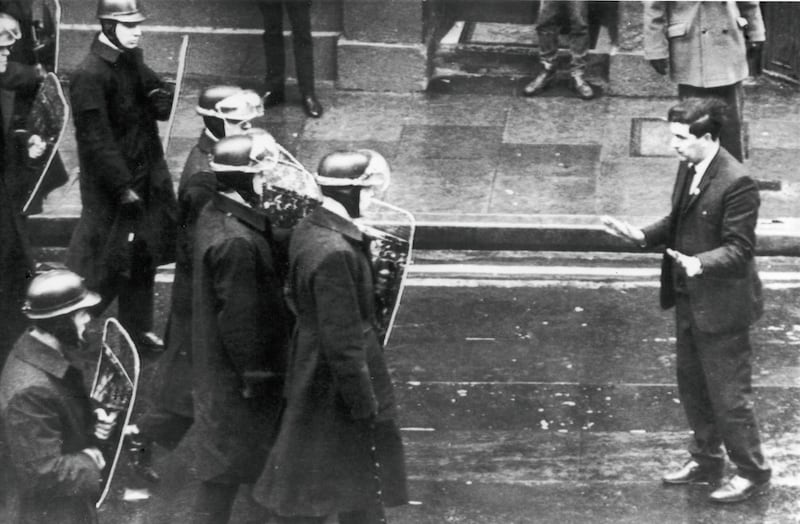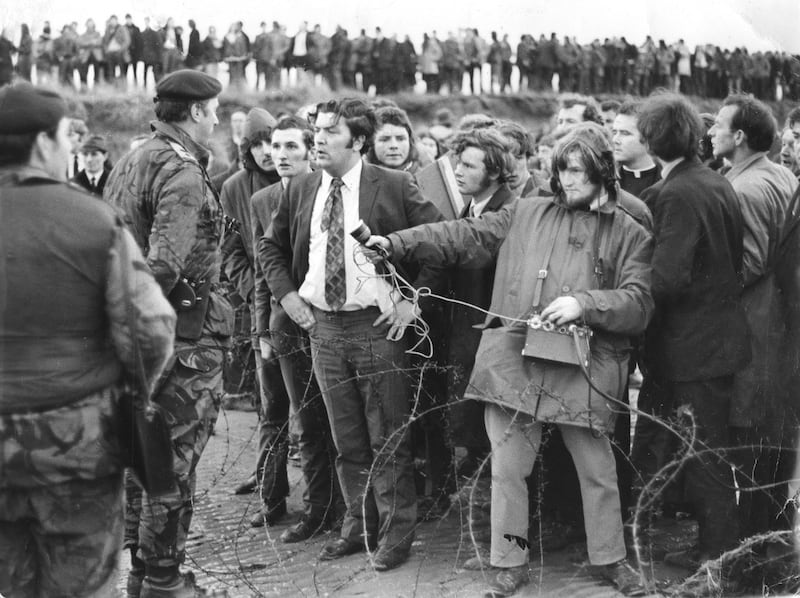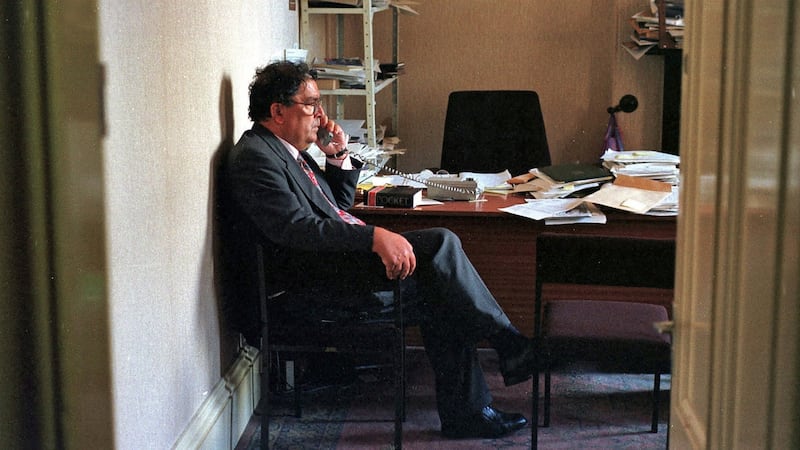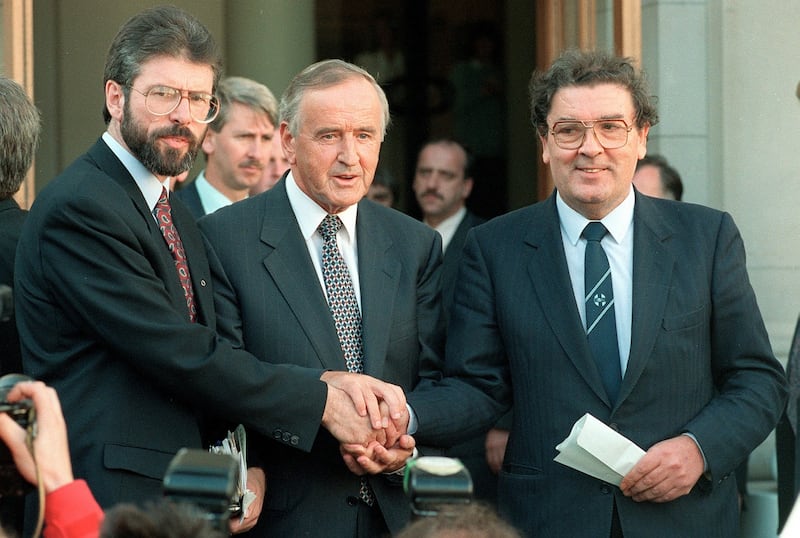Growing up in the Hume family home in West End Park in Derry in the 1960s, 1970s and later could be "bedlam", says Mo Hume, youngest of John and Pat Hume's five children.
She and her siblings, Therese the eldest, and Aidan, Áine and John would have their friends around; her dad, who died a year ago, would have senior politicians from Ireland, Britain, Europe and the US visiting at all hours of the day and night, wondering how to kick-start a peace process; Derry people called looking for assistance on local constituency matters.
At least, Mo recalls, they had a great woman they called Nana, a close friend of their granny's, "a red-haired, Park Drive cigarette-smoking character" and a daily 8am Mass-goer in nearby St Eugene's Cathedral. She helped out when Pat Hume was teaching and Mo's father was away in Belfast, Dublin, London, Brussels or Washington. "She was great craic."
And then there was John Doran, brother-in-law of a neighbour who loved playing tricks on Nana, ringing up regularly, pretending to be somebody important.
“That was when she put on her telephone voice,” remembers Mo. “One time she got a call from a man saying he was the Bishop of Derry. She said, ‘f**k off, John Doran’.
“But it was the Bishop of Derry. But luckily it was Bishop [Edward] Daly and he was just gorgeous, he was just a pet.”
So Nana got over her mortification.
“You know, life was really rich. I just remember lots of laughter and lots of stories,” says Mo.
Mo cites Brian Friel and his play, Philadelphia Here I Come, where you saw two sides of the main character, Public Gar and Private Gar. Here mostly she talks about Private John
On Tuesday she and much of the extended Hume family, led by Pat Hume, will gather once again in the cathedral for the first anniversary Mass for John Hume. With her will be her sisters, Áine and Therese. Aidan in the US and John, who is in France, won't be able to make it. The day also will involve a visit to the city cemetery in Derry where a headstone was erected recently.
It's a simple one made of slate sourced in Inishowen and sculpted by Redmond Herrity from Co Donegal. It features the oak leaf symbol of Derry and "John Hume 1937 – 2020", plus a kneeling stone with the word "Síocháin", peace in Irish.
It will be a private affair mainly because of Covid and also because the Humes, despite the former SDLP leader’s fame, are a private family. Mo says this is the first such interview she has ever done and it is obvious it’s an experience she does not take pleasure in, although she is open and friendly.
The conversation takes place in an apartment in Clarendon Court, also near St Eugene's Cathedral, where the Humes moved when John Hume's dementia started to encroach on his great mind.

Áine also was due to join in but she is hors de combat from Long Covid in another room. She comes out to say hello at the end of the interview, still shook but feeling she may be on the mend. Pat, their mother, is in the family holiday home across the Border in Greencastle, just out of hospital and recuperating from treatment for a heart condition.
When he challenged the IRA throughout the Troubles he was attacked by republicans. 'There were a few really bad attacks, and then there were lots of small attacks'
Trevor McBride, who in 1968 took the famous photograph of John Hume speaking to the civil rights crowd close to Craigavon Bridge in Derry – which was used as the wraparound cover of The Irish Times marking John Hume’s death – is busy organising photographs, again an experience new to Mo. “You owe me one,” she jokes to Áine about having to carry the interview.
Mo, reflecting on her father, cites his great friend Brian Friel and his play, Philadelphia Here I Come, where you saw two sides of the main character, Public Gar and Private Gar. Here mostly she talks about Private John. So, the stories mainly are of the family, and not of Hume as Nobel laureate, as the former SDLP leader who as far back as 1964 in a series of Irish Times articles delineated the non-violent, powersharing, consensual framework for the peace that ultimately was achieved.
Her childhood was not all fun and laughter, she also recalls. When John Hume worked with Gerry Adams in the early 1990s to create the conditions for the first subsequent IRA ceasefire in August 1994 he was assailed by unionist politicians and threatened by loyalist paramilitaries.
When he challenged the IRA throughout the Troubles he was attacked by republicans. “There were a few really bad attacks, and then there were lots of small attacks.”
The “small attacks” constituted daubings on the house with local republicans branding her father a “traitor” or other such comments, much of it in the late 1970s and 1980s when she was growing up.
“Every day I walked to school past ‘Hume – traitor’ on the walls.” It was only as an adult that she reflected that “that’s a bit mad” but then, not unlike some of the scenes in Derry Girls, she did not pay it much mind because “to be honest, that is what I was used to at the time”.

There were regular visits to the shops to buy paint stripper. “My mum would be asked, ‘Are you still decorating’, and she’d just reply, ‘Yeah’.”
In one of the bad attacks Mo was at the window at West End Park when it was smashed with ball bearings, then came the petrol bombs exploding across the window. Luckily a second inner window, there as a protection, was not penetrated.
I remember asking him, again as a small kid, why he didn't have a bodyguard, and he said 'Well, why would I put someone else's life in danger to protect me?
“You heard the smash, and then the window went up [in flames]. And they would have seen a kid, like a 12-year-old, sitting in the window. There was intent behind that one.
“And the irony was, if they’d been clever, they could have just opened the front door because the door was unlocked. Our door was never locked.”

She adds, “I remember asking him, again as a small kid, why he didn’t have a bodyguard, and he said ‘Well, why would I put someone else’s life in danger to protect me?’ And he was very against weapons anyway.”
Mo recalls too another bad attack when she was younger. “I was very small. I was probably about nine or 10. I was worried that they were coming to kill him. And I remember being on the stairs in West End Park and him just kind of hugging me and saying ‘It’s alright, it’s alright, don’t worry…’.”
“He was fearless,” she adds.

Therese is a lecturer in computers in Sligo IT, John runs a communications business in Dublin, Aidan is in banking in Boston, Áine is a GP in Derry. None of them followed in their parents' steps apart from, up to a point, Mo. She is professor of Latin American politics at Glasgow University. Prior to that she worked during some tricky times in El Salvador.
During elections, her father survived on 'black coffee and Crunchies'
“Dad always said that none of us made the choice to have a public profile. And, with Mum, he was very careful about that, about keeping us out of the public glare, if you like.
“I think one of the things that my parents did – and you can see this from how we all do very different things – they encouraged us to find our own path. And to find it in ways that were about us rather than about ‘in his shadow’. And I think that was really important to all of us as well, just forging our own way. They were hugely supportive of that.”
Still, unlike her brothers and sisters, she enjoyed election time in Derry and going around in the election car or on canvasses, as her dad urged people to vote for him and his party. She has massive admiration for all the SDLP people who soldiered with him and her mother.
During elections, her father survived on “black coffee and Crunchies”, the bars, shared with her. When her older siblings had moved from home Sunday nights used to be called “Yorkie night”, when the chunky bars were bought from the corner shop. “That was his favourite chocolate, at that point. His favourite dessert was crème brûlée, and that was kind of non-negotiable.”
Her parents liked to visit St Theresa's church off Grafton Street when they were in Dublin and how a woman who regularly begged there would often end up with a €50 note
He also loved the aromatic Gewürztraminer wine, which is not to everyone's tastes. After he died Trish and Eoghan Kealy from Kealy's restaurant in Greencastle – "his favourite, favourite place to go" – dropped the family in a box of Gewürztraminer because no other customer drank it, and a "load of crème brûlées".
Mo says her father “was probably the least materialistic person” she has ever encountered. It is well known that he gave away the hundreds of thousands of pounds he won from the Nobel and Gandhi peace prizes.
She tells, too, how her parents liked to visit St Theresa’s church off Grafton Street when they were in Dublin and how a woman who regularly begged there would often end up with a €50 note. “She loved seeing him. If he had it he would share it.”
It was only in the 1980s that the Humes felt reasonably financially comfortable to allow them to build their holiday home in Greencastle. It was the family’s bolthole, a refuge from the pressure of heavy-duty politics and paramilitary threats. It was designed by a family friend, the late architect Liam McCormick.
Just like West End Park, Greencastle had numerous high-ranking visitors. Mo was not particularly taken with them, apart from Mary Robinson. "She did the dishes and I was impressed by that. The men would come and just expect to be served."
She allows her father wasn’t a “new dad”. “I think maybe he may have changed one nappy out of the five of us, but did it so badly that there was never even the question of being asked again.
“He was always very busy; he could sometimes be a bit, you know, absent behind the newspaper. But he enjoyed challenging conversations. He enjoyed me questioning him – he liked that, he always answered questions.”
Even with the onset of dementia he still had a presence. Mo loved the observation from his granddaughter Róisín, which was read at the graveside a year ago, how even with his memory loss “Grandda filled the room”.
“He was still that very determined character. And, you know, he still managed to kind of get his own way, but with charm. Right to the end, things like music were hugely important to him. He could still remember and sing the songs. You still managed to get a sense of him.”
I don't think he could have achieved anything without my mum
Over the days ahead, there will be plenty of memories to provide comfort but the anniversary still will be difficult for Pat – the quiet hero of the Hume world – and the family.
Last December would have been Pat and John Hume’s 60th wedding anniversary. Says Mo, “He was such a huge part of who she was and she was a huge part of who he was.
“I don’t think he could have achieved anything without my mum. She was, if you like, the foundation of it all. He often joked that he was a package and it was Pat who delivered him.”
Mo says faith was important to her parents but in a “very private way”. “There was a wee gate near the flat and he would go out of an evening, and just either go to Mass or just sit after Mass quietly [in St Eugene’s Cathedral], and then slip out the back gate into the Park Bar for a wee glass of wine, and then come home.”
She says that the people of Derry and of Greencastle and Moville always looked out for her father and she and all the family are eternally grateful for that support, love and solidarity.
Mo is conscious of her father’s place in modern Irish history but, she says, in an “abstract way”. Séamus Mallon comparing Hume with Parnell and O’Connell was “gratifying”, particularly as it came from a man she much admired.
She dismisses the idea there was genuine animosity between them, although she accepts the pair of them could be “thran” – stubborn. “They were like two brothers, you know, they complemented each other.”
An element of the dementia, she says, was that her father “kind of fell out of the media spotlight and we kind of got used to that”. That, again in the context of the private and public, allowed the family focus on the Private John, on the Private Dad, so to speak, in the last years. And that is where the best memories reside for Pat and the five Hume children, 16 grandchildren and two great-grandchildren.
“Obviously we’re hugely proud of him and hugely proud of what he did,” says Mo. Then she adds. “It might sound hugely naïve, and it probably does, but we did not quite realise how significant he was until he died.”







